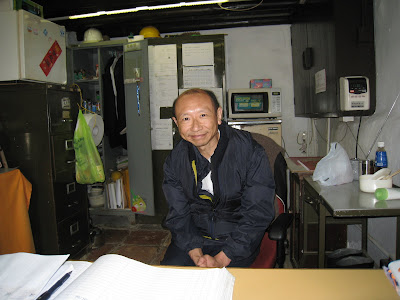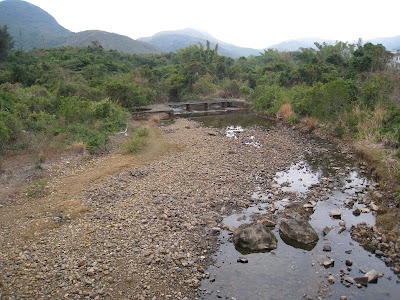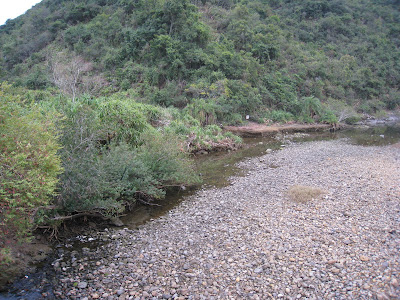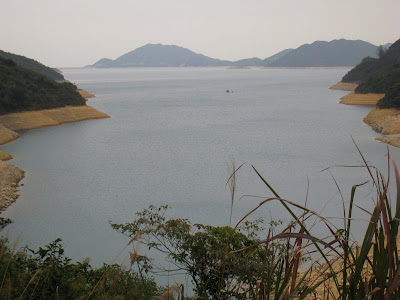
The footpath, now called the Pak Tam Chung Trail, is paved, but I don't mind because it winds along the pristine Lung Hang River, which must be one of the last rivers not to be concreted in Hong Kong. I also pass four traditional houses which have gardens with banana, sugar cane, tangerines, mangoes and other crops being grown. There's a beautiful grove of trees on the hillside above the houses. This morning the householders had some tangerines for sale by the footpath.
Kevin Sinclair, who wrote lovingly about the New Territories, says the the walk is "a gentle stroll into the past" and the reason becomes clear when the Sheung Yiu Folk Museum comes into view. The museum was the site of eight houses occupied by the Hakka Wong clan which moved to these parts about 150 years ago. According to Sinclair, the Guandong coast was plagued by pirates and waterborne bandits at that times, so the Wongs built their village behind strong stone walls overlooking a narrow cove facing Jade Bay. The entrance to the museum, shown below, gives an idea of the fortifications.
Patrick does not work regularly at this museum. He is now attached to the museum in Tsuen Wan and only comes to Sheung Yiu on the last working day of the month. He was happy to see me (we have known each other for 8 years) and we chatted for a while. He seems older and says he is worried about "minor things" which he didn't elaborate on. I asked him not to watch the news or read newspapers too often, because there's only bad news these days. Unmarried, he lives with his mother of 76 years.
He has added about 100 lines to "A Ballad", and we talked about Pak Tam Chung, the museum, and other matters. When I began complaining about the elaborate garvesites that are springing-up all over the New Territories, Patrick said he didn't need a grave. Instead, he would like his ashes to be scattered in Pak Tam Chung. That's in keeping with the man, his modesty and simple lifestyle.

Patrick in his office.
A few times a year, I pay a visit to the two abandoned villages that lie along the path, Wong Yi Chau and Hei Tsz Wan. I have written before about these villages but this was the first time I took a camera along. Long abandoned, collapsing houses can be seen along the path even before one gets to the two villages.
The Wong clan were Catholics, apparently converted by an Italian missionary in the late 1800s and early 1900s. A few meters beyond the museum lies Our Lady of Seven Sorrows chapel, built in 1900 to serve the congegration of the Sheung Yiu, Wong Yi Chau, and Hei Tsz Wan villages. Because the villagers have moved away, the chapel is now being used as the Sea Activity Center of the Catholic Scout Guild. A few canoes that lie alongside the chapel is evidence of these "sea activities". An interesting banner that hangs outside the chapel shows a map of the Sai Kung and Tai Po areas indicating where chapels and churches have been built, the earliest in 1873 and the last in 1910. The catholic congregations in Sai Kung and Tai Po are thriving but most of the chapels must now be abandoned.

Our Lady of Seven Sorrows Chapel, built in 1900

Electricity and pipe borne water is supplied to these houses and there is no doubt that the villagers and their descendants return here on festival days. There is some activity on the waterfront below, with some canoes in the open area. Amazingly, after walking through the dilapidated village, I come across this newly built, well maintained ancestral hall. The view of Jade Bay from the ancestral hall is idyllic.



Back on the footpath, I now walk towards Hei Tsz Wan village. The trail winds along a low lying, marshy area which contains tall grasses. A can see a few gravesites but the terrain here is treacherous because of wells that lie hidden in the grass.























































